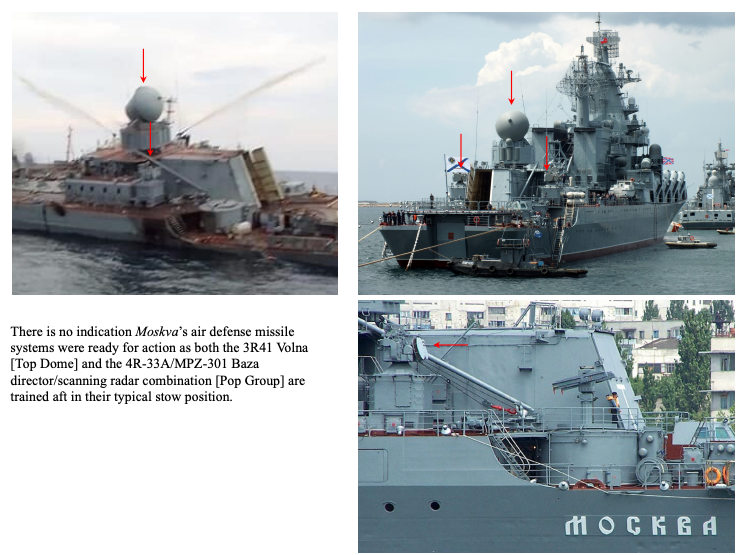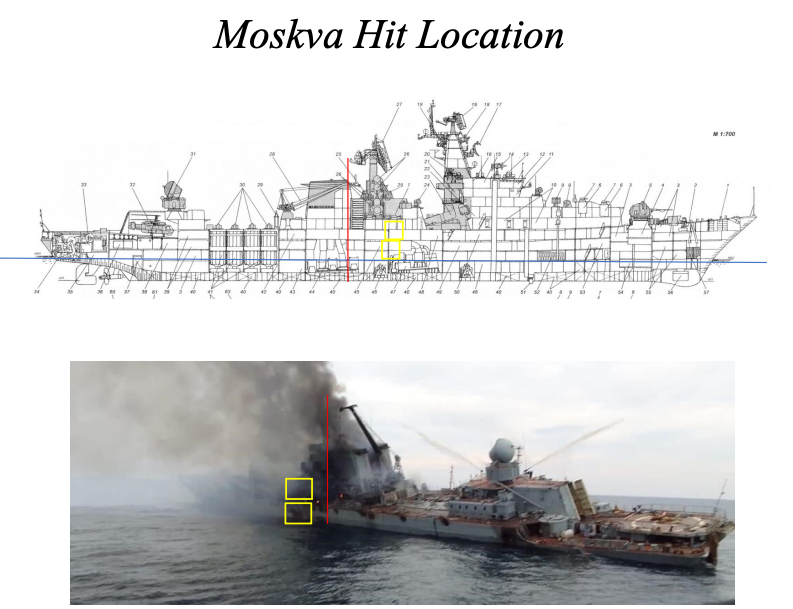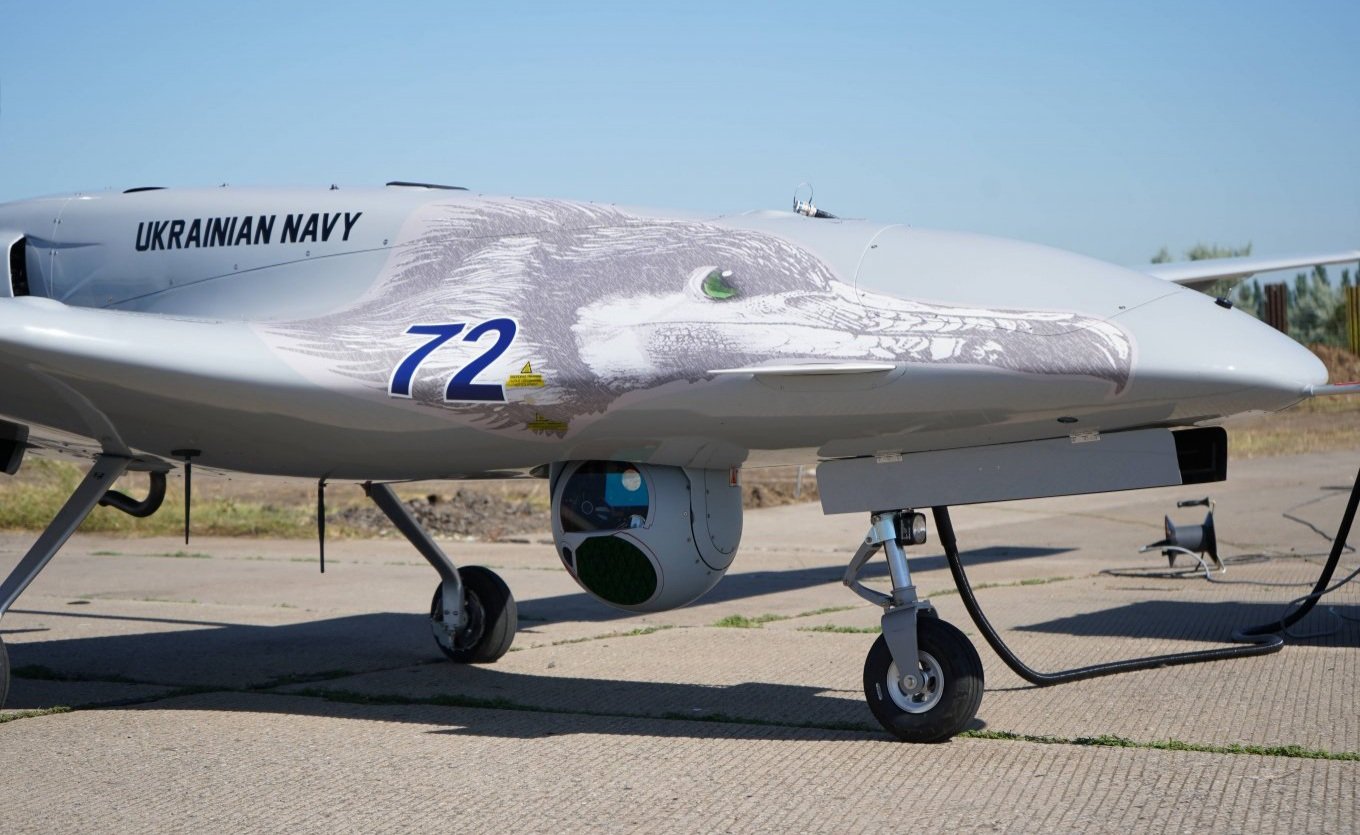
This post has been updated with additional information on the Moskva’s radar system.
The crew of RTS Moskva (121) was blind to and not ready for the Ukrainian missile attack that sank Russia’s Black Sea flagship, according to a new analysis of the April 13 strike reviewed by USNI News.
The review of images following the strike of the two Neptune anti-ship missiles from open-source naval analyst and retired Navy Capt. Chris Carlson told USNI News that the guided-missile cruiser did not have its fire control radars activated and could not see the threat from the two sea skimming weapons.
In the photo of Moskva after the strike, the radars “are in their normal stowed position,” Carlson told USNI News on Monday.
“If you look at the pictures of Moskva, when she’s just dancing around going from place to place, or she’s anchored as a showboat, those directors are all facing aft every time,” he said.
The analysis is based on images of the Slava-class guided-missile cruiser that emerged just after the attack off the coast of Ukraine from what the Ukrainians claim were two Neptune-class anti-ship missiles.

While the Russian warship had older point-defense systems, they would have been capable of countering the Neptune missiles based on a 40-year-old Soviet design, which was in turn based on the U.S. Navy’s Harpoon anti-ship missile, he said.
“This is like Harpoon. It’s a small missile. Its warhead is about 145 kilograms, travels less than 10 meters off the deck [and has] radar homing,” Carlson said. “This is not, shall we say, a stressing threat for air defense systems. It’s not supersonic.”
In particular, the radar system that would have directed Moskva’s OSA-M surface to air missiles to counter the Ukrainian missiles appears to not have been active with its emitters stowed, based on the photograph.
“If you’re not running it, your point defense [surface to air missiles] are not going to be playing,” Carlson said.
In addition, on Moskva, “you’ve got old stuff, which means it’s temperamental. It’s hard to maintain, and at-sea maintenance has not been a Russian strength.”
While it’s unclear from the photos published from the Russian MoD, the cruiser’s role as part of the air defense mission in the Black Sea would likely mean its two main air search radars were operating, Carlson told USNI News following an earlier version of the post. However, the MR-710M Fregat-M Flag MR-800 Flag air search radars would have had a hard time to detect the wavetop skimming Neptunes. Even if they had detected the missiles, the crew did not react time to employ defensive weapons as the fire control radar were still stowed according to the photo, Carlson said.

Based on the photographs that circulated following the strike, the two Neptunes hit the warship near its most vulnerable point: the ship’s main propulsion spaces, dead center of the ship, just above the waterline.
“A missile hit in the forward engine room would very likely cause significant damage to the cruise gas turbines and steam turbines and could potentially distort the main shaft sufficiently to cause damage to the reduction gears of the boost turbines,” Carlson wrote. “Heavy damage in the post of energy and survivability compartment could cause a loss of all electrical power, as well as potentially disabling the ship’s automated damage control capability.”
Combined with the Russian Navy’s uneven training for sailors in damage control, Carlson said the photographs lend credence to Ukraine’s explanation that they were able to target, fire missiles and hit the target with their own resources.
Following the initial strike, a Telegram channel with ties to the Russian mercenary Wagner Group said the crew observed Ukrainian Bayraktar TB2s near the ship. The Ukrainian Navy began acquiring the combat drones starting in the last year and they are equipped with an electro-optical system that’s capable of providing the Neptune command system enough information via datalink to target the missiles.
“All they have to do is laze once or twice and then they have a feasible targeting solution,” Carlson told USNI News.
Shortly after the sinking, reports emerged that a U.S. Navy P-8A Poseidon was in the area before the attack, suggesting that the U.S. may have provided detailed targeting information to the Ukrainians to target the ship.
Carlson said while the U.S. could give Ukrainian forces a general idea of where the ship was, it could not provide necessary tracking information to the Neptunes because P-8s datalinks were incompatible.

“There’s no way the P8 has the ability to send direct data via data link right to the Ukrainians,” he said. “You can’t do it by voice. It’s got to be done through a data link.”
On Thursday, following a Wednesday story from The New York Times on the targeting of Russian general officers, Pentagon spokesman John Kirby said the U.S. intelligence sharing with the Ukrainians has limits.
“We do not… participate in the targeting decisions of the Ukrainian military. Ukrainians have quite frankly, a lot more information than we do. This is their country, their territory, and they have capable intelligence collection abilities of their own,” he said. “Ukraine combines information that we and other partners provide with the intelligence that they themselves are gathering on the battlefield and then they make their own decisions, and they take their own actions.”





